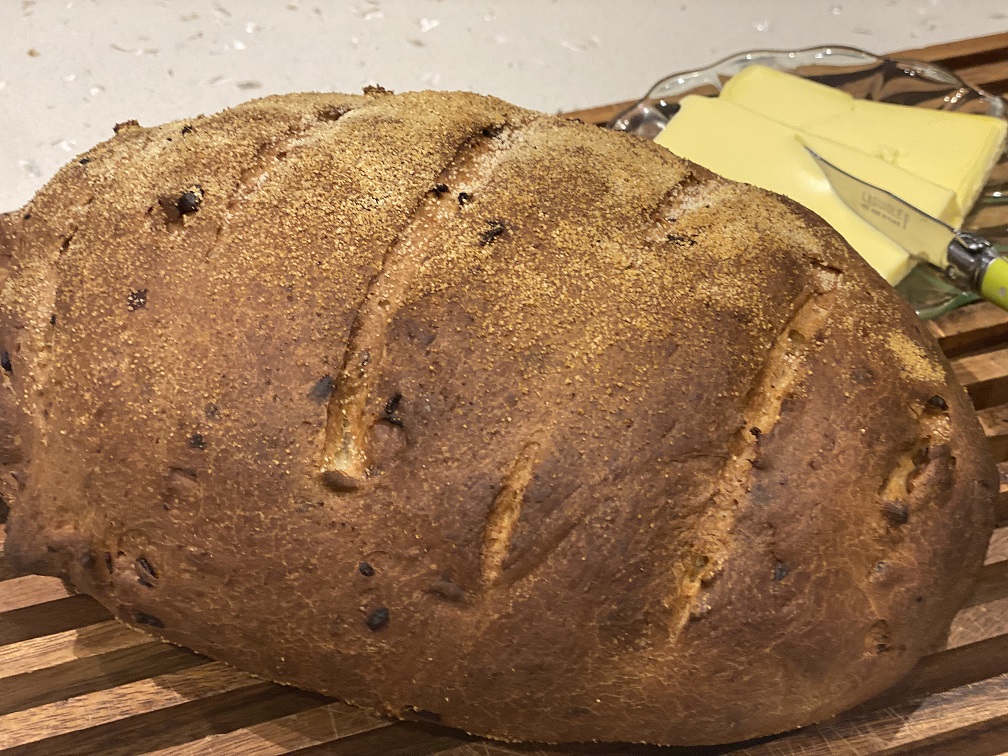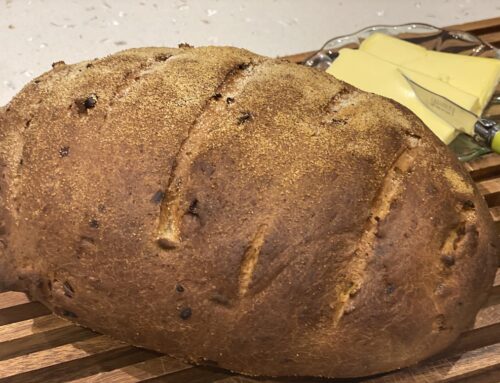This is a versatile bread served either fresh or toasted and is a wonderful accompaniment to cheese and wine. I always serve it with the ‘Blue cheese and walnut terrine’, which you will find in the website recipe collection as well. Bread is not time-consuming to make, but it does require a little forward planning to allow for the 2 provings of about an hour each.
Ingredients:
450g strong white bread flour
60g wholemeal flour
3 tsp salt
1 small onion finely chopped
5 grams butter
1 -2 tbsp oil
60g coarsely chopped walnuts
12g dry yeast or 15g compressed fresh yeast
250ml milk at room temperature
60g unsalted butter, well softened, at room temperature
160 ml water at room temperature
2 tbsp semolina, polenta or cornmeal
Method:
Weigh and measure all the ingredients. Sift the flours and salt into a large bowl and mix them together.
Finely chop the onion and gently sauté it in a frying pan with oil and butter, for 10 minutes until caramelised and golden, without burning them; set aside to cool.
While the onion is cooking, coarsely chop the walnuts. Set aside.
In a small bowl, mix the yeast with 20ml milk to form a smooth mixture; wait for the yeast to re-activate and form bubbles in the mixture. Yeast is a living organism and when used, it needs to be re-activated, to ensure it is alive and will be an effective raising agent in the bread.
Take the large bowl of dry ingredients, make a well in the centre, add the yeast mixture, into the well. Slowly add the remaining milk and softened butter, mixing with your hand.
Continue mixing the dough in the bowl adding the water, as necessary, slowly a little at a time to form a smooth elastic dough. You will most likely, not need all the water, so add it slowly to get the smooth elastic dough. Dust with extra flour if necessary. When the dough has formed, open a pocket in the dough and add the cold onion, without any excess oil and the walnuts.
Incorporate the onions and nuts by kneading and folding the dough. It should leave the sides of the bowl and the bowl should be clean.
Turn onto a floured work surface and knead for 10 minutes. Return the dough to the bowl and cover with cling wrap. Let it stand in a warm place to prove until it has doubled in size, usually about an hour in warm weather.
When the dough has doubled in size, ‘knock it back’ by punching into it to remove the air, turn it out onto a lightly floured surface and knead for another 5 minutes until it is smooth and elastic. Form into a round loaf.
Place the dough on a slightly oiled baking sheet, sprinkle with semolina and allow to prove again until doubled in size.
Pre-heat the oven to 210°C. Place a tray of water or ice cubes in the bottom of the oven if yours is not fitted with steam injection.
Slash the top of the loaf about 5 times with a sharp knife or razor blade. Bake for 20 minutes. Remove the pan of water.
Reduce the temperature to 160°C and bake a further 40 minutes or until it sounds hollow when tapped on the bottom.
Cool on a wire rack. When cold, wrap in a tea towel and store in airtight container.
The ancient 16th-century water mill, for grinding the nuts, called Moulin de la Tour, in the tiny hamlet of Sainte-Nathalène, near Sarlat, Dordogne, southwest France.
When in France some years ago, I visited the ancient 16th-century water mill, Moulin de la Tour, in the tiny hamlet of Sainte-Nathalène on the edge of the small Enéa river, near Sarlat in the Dordogne, southwest France. The wheel of the mill turns an old-fashioned grinding mechanism that crushes the nuts under a huge stone and the resultant paste is heated before being pressed and filtered for its oil
When we were visiting, they were processing the walnuts to make the precious, huile de noix, walnut oil. The owners are passionate about making these oils in a traditional artisanal manner. Watching the walnuts being crushed and seeing the oil dripping from under the massive stone into the receptacle was a slow but fascinating process. Sadly, these practices are disappearing.
These photos include the small retail outlet for purchasing the precious oils, sold conveniently in small tins, plus the beautiful old mill in the garden setting and part of the process of extracting the oil.
The photos below were taken at the Moulin de la Tour. You can see the huge stone used to crush the nuts, and after a few exacting processing procedures, the walnut oil finally drips out at the end of the process. Then it is off to visit the little shop to buy some walnut oil to take home.
- Grinding the walnuts under the huge stone
- Oil making process at the mill
- The end of the process, sees the walnut oil dripping into the receptacle
- Precious oils freshly made
- Walnut oils, nuts at the old mill
- Walnut and onion bread
Add images













